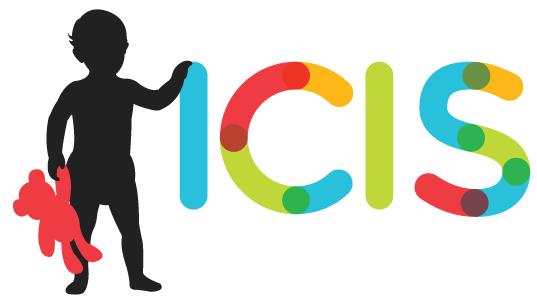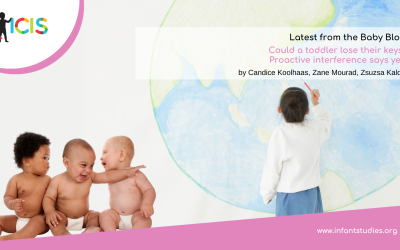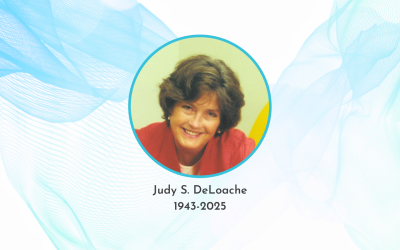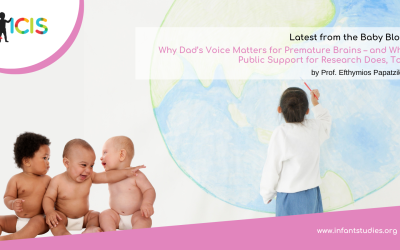Developmental electroencephalography (EEG) is a constantly evolving field with researchers actively exploring cutting-edge approaches to studying brain development. One novel approach involves looking at live, naturalistic interactions by measuring changes in an infant’s EEG as a response to discrete ‘events’ or conditions. Another approach looks at general patterns in a free-flowing interaction rather than discrete events, and finds relations between infants’ EEG and ongoing environmental stimuli such as speech. A third approach looks at statistical ‘profiles’ or groups that emerge from studying infants’ ‘resting’ EEG, which captures background brain activity related to brain maturation and organization. All three of these approaches were showcased in a recent ICIS Webinar.
The first approach, discussed by Dr. Lindsay C. Bowman from the University of California Davis, consists of event-related analyses of live, naturalistic interactions between the infant and a social partner. The basic experimental design for this type of research involves an infant wearing an EEG cap while interacting with a social partner, coding for ‘events of interest’ (EOI) such as an infant’s gaze shift indicating a shift in their attention, and measuring the corresponding changes in the infants’ EEG. To do this, researchers must create experiences where a target EOI will occur, and then analyze the resulting EEG output in relation to the EOI and proposed hypotheses. This method allows researchers to examine an infant’s neural responses in an ecologically valid way by providing live events as stimuli, rather than the classic computer-based paradigms that can only simulate real-life events of interest.
Despite its enhanced ecological validity, there are challenges to this approach including equipment setup, study design, and analysis parameters. For example, because this method requires infant-caregiver interactions, the classical approach of having the infant sit on the caregivers’ lap is not appropriate. Possible solutions involve using carefully sourced chairs (e.g., a “sit-me-up” chair for young infants to provide security and prevent EEG cap compression). There must also be multiple camera angles to capture both the behavior from the infant and also the interacting social partner (e.g., caregiver). Researchers can use a hidden earpiece to communicate with the caregiver while allowing for a more naturalistic interaction as opposed to the experimenter being in the room and possibly causing disruptions to the interactions.
Following data collection, researchers use an analysis technique called ‘event-related EEG spectral power analysis’ to compare the data captured during a target event of interest (EOI) in relation to the data taken during a ‘baseline’, or non-target event. Good baselines occur close in time to the EOI, preferably directly before it, and are similar to the EOI. Researchers must determine what their baseline will be, and also how to select an ‘epoch’ or time frame of EEG to analyze for their EOIs. For example, if researchers want to study infant brain activity supporting infants’ attention to an object to which their caregiver is also attending (a type of activity called ‘joint attention’), then researchers must decide when to extract the EEG data to best capture the brain activity associated with this EOI— should the epoch begin before the infant shifts their gaze to the object? After? During the shift? Researchers must consider these issues when analyzing EEG data, and often will use previous studies to inform their analysis decisions.
A second cutting-edge approach to infant EEG research was discussed by Dr. Sam Wass from the University of East London, who also studies EEG during free-flowing naturalistic social exchanges. Dr. Wass’ approach—unlike Dr. Bowman’s—focuses on non-event-locked analysis, meaning that instead of finding specific events to analyze (such as an infant gaze shift), researchers examine the entirety of a free-flowing interaction, and look for patterns of connection between the neural activity of the two interacting partners. Like Dr. Bowman’s approach, this approach enables examining infant brain activity supporting live, naturalistic interactions, which Dr. Wass noted improves significantly upon past non-naturalistic techniques. For example, previous, non-naturalistic studies examining infants’ brain responses to gaze aversion, gaze following, and emotional expressions have limited real-world application because these studies flash static images of faces on a computer screen out of nowhere and for brief time periods, unlike the continuous reality people actually experience. Human social interaction is just that—interactive—and so examining infant brain activity only during passive-non-interactive computer-based paradigms seriously limits our understanding of how the human brain actually works to support activity in every-day life.
Similar to Dr. Bowman, Dr. Wass also discusses the challenges to studying EEG in a free-flowing and naturalistic environment. Chiefly, EEG data is susceptible to ‘artifact’ or ‘noise’ generated by movements of the body, face, and eyes, which mask researchers’ ability to analyze actual brain signals captured in the EEG. One possible solution to the artifact problem would be using software that allows for tracking minute movements based on previous data. These software programs, such as OpenFace and MediaPipe, allow researchers to get micro-levels of how participants move their heads and can quantify their facial expressions so that these influences on the EEG signal can be filtered out. Another solution involves side-stepping artifacts entirely by finding specific relations between infant brain activity and the free-flowing naturalistic stimuli in the environment, such as speech patterns during caregiver-infant interactions. Researchers can use statistical modeling that identifies an environmental stimulus (e.g., caregiver speech) and evaluates whether and how the infant brain activity changes as a function of the environmental stimulus pattern. This same modeling approach also allows researchers to examine how the infant brain activity may be related to the brain activity of their social partner during an interaction. These kinds of methods are referred to as environment-brain and brain-brain ‘entrainment’. Entrainment methods can address several problems related to EEG artifacts.
A third approach to infant EEG research was discussed by Dr. Lara Pierce from York University. Unlike Dr. Bowman and Dr. Wass, Dr. Pierce discussed how to examine infant brain activity from ‘resting’ EEG, which is the EEG recorded when infants are not doing any sort of interaction or task in particular. Of course, the brain is always ‘active’, even when we sleep, and so there is always brain activity to measure. The measurement of ‘resting EEG’ is meant to capture a picture of the activity in the ‘idling’ brain, which captures ‘background’ activity related to general brain maturation and organization.
Dr. Pierce discussed a new statistical technique for extracting information from resting brain activity called ‘Latent Profile Analysis’. This technique separates participants into ‘profiles,’ which consist of groups of participants that show similar responses across multiple measures (e.g., of the brain, demographics, cognition). This approach helps researchers to identify unique patterns of EEG activity that exist within our diverse human population, providing insight into which measures or ‘variables’ predict a given profile’s development; for instance, whether those who exhibit that profile are likely to share later developmental outcomes. Specifically, latent profile analysis uses the ‘scores’ of an individual on a given measure—called an ‘indicator variable’—to calculate the probability that the individual belongs to a particular profile. Researchers use theory to select a number of indicator variables and then run a sequence of models to obtain the “best fit” for different profiles. This method is broadly applicable to all sorts of investigations, and has the advantage of being able to consider the combined influence of multiple different variables altogether (such as gender, cultural background, multiple aspects of the EEG signal), rather than having to separate these variables. Thus, latent profile analysis broadens our understanding of the complex and interactive influences distinct variables have on infant development.
In sum, the webinar showcased the value of using EEG in understanding infant development, and highlighted different approaches: both event-locked and entrainment analyses of EEG collected during live, naturalistic social interactions, and latent profile analysis of infants’ ‘resting’ EEG. All three approaches are on the cutting edge of developmental EEG research, and open up many new avenues for future work.
About the Author

Amanda Soeth
University of California Davis
Amanda Soeth is a fourth year undergraduate research assistant at the University of California Davis, majoring in cognitive science with an emphasis in neuroscience. She has been working in Dr. Lindsay Bowman’s Brain and Social Cognition (BASC) Lab for the past three years as a tester and coder for various projects. She is planning to graduate in Spring 2024 and hopes to continue studying psychology and neuroscience in a graduate program.

Dr. Lindsay Bowman
University of California Davis
Dr. Lindsay Bowman is an assistant professor of Psychology at the University of California Davis, and Principal Investigator of the Brain and Social Cognition (BASC) Lab. She received her Ph.D. from the University of Michigan in Developmental Psychology. With experience as a post-doctoral researcher at the University of Maryland Child Development Lab and as a research fellow in the Labs of Cognitive Neuroscience at Harvard Medical School and Boston Children’s Hospital, her work brings together unique perspectives on neuroscience, cognition, social understanding, and development. Her lab uses a combination of neuroscientific and behavioral methods to understand how cognition develops over infancy and childhood, and how these early developments set the course for social success or impairment.




